| Columns Retired Columns & Blogs |
I good read, times may change and we may grow older but great music is just that great. Nothing like driving through Texas and remembering the times they played with Joe Ely a personal favorite of mine.
London Calling also has a few nods to Americana—not as a pitch for a share of the middle-of-the-road record market but at least partly because they thought American mythology was cool. (Since the Second World War, the Atlantic was never a barrier to cultural cross-pollination.) Besides, the Clash always loved striking a pose, whether dressing up as baseball players or gangsters—or writing Hollywood slang into a song, as in "The Right Profile," in which Strummer almost gleefully recounts the tragic story of actor Montgomery Clift. The song evokes a Saturday morning at the cinema, munching popcorn and reveling in the Hollywood glamor and scandal. It's more about escaping life's tedium than appropriating a medium—and of course, Clift was very hip.

Similarly, the band's choice of Vince Taylor's "Brand New Cadillac" is a telling one. Of all the rock'n'roll records they could have covered, they choose an obscure one by a Brit. And for my money, Strummer's snarling "Driiiiive," spoken before a note is sung, is up there with Roy Orbison's "Mercy" on "Pretty Woman" as the coolest single-word utterance in a song—one that demands you wear sunglasses when listening to it.
The
The Clash were scarcely able to convince CBS/Epic to release London Calling as a double album. At first, the label insisted on a single LP, then caved slightly and approved the inclusion of a free 12" 33.3rpm single—at which point the band simply went ahead and filled that second disc with a total of nine songs. That London Calling works over four sides owes a lot to the final production work and sheer discipline provided by chief engineer Bill Price, and to Mick Jones's track sequencing. But the main reason it works is, the songs are brilliant. The album maintains its purpose. (And yes, it's impressive that the band insisted that this double album be released at little more than the price of a single one.)
And that would-a-been 12" single? That song, called "Train in Vain," was added to the end of the master tape at the last minute—too late to be listed on the back of the jacket or the LP label for the first pressings. (Art Dudley, who bought his copy of London Calling the weekend after its US release, remembers grooving on the song for months before learning its title: The words "train in vain" don't appear in the lyric.) It wasn't the fact that the song is a "hidden track" that astounded me, but rather the fact that "Train in Vain" is—good grief!—a fairly straightforward, poppy love song. And this from the Clash!
Walls!
Punk had set out to destroy the deadwood of self-indulgent pomp- rock; having seen to that, it was time to get back to basics and create a new sound. London Calling's iconic cover—an overused phrase, I know, but appropriate here—captures this idea very well. It's a black-and-white photo, by Pennie Smith, of Paul Simonon smashing his Fender Precision bass onstage at the Palladium in New York City. To this image, designer Ray Lowry added pink and green lettering, borrowed from and in homage to Elvis Presley's debut album.

The Clash weren't alone in thinking of reconstruction. A year earlier, rival band the Jam had recovered from a truly dire second album (is there a pattern here?) by releasing the excellent All Mod Cons, using '60s mythology in much the same way as the Clash dipped into the '50s for London Calling. A lot can be said of the influence of the roots of rock'n'roll on both those albums—and surely others of the day—but this also raises the question: To what extent did these post-punk survivors influence each other Another great London Calling track, "Lost in the Supermarket," with its expressions of alienation and the commodification of life, could easily have been written by X-Ray Spex. Other albums released during the second half of 1979 include Cut by the Slits, Metal Box by PiL, and debut albums by the Specials and the Raincoats, to name just a few. (Strummer and Jones were friends with many of those musicians: It would have been strange for them not to be affected by this.) After the initial punk explosion, bands were setting no limits. Punk had blown open a space in which bands could exercise their creativity by moving in a myriad of stylistic directions.
What many successful post-punk groups had in common, and what set them apart from classic punk, was the move away from guitar rock to even more rhythmic—and rhythmically nuanced—music. With Simonon's developing skill as a bassist and drummer Topper Headon being given the room to play, the Clash could now do likewise: The pogo was old news; move your hips was the call. London Calling reminded listeners that the Clash were still vital, and in the process reminded other musicians that they had a large, colorful palate of sounds to choose from.
London Calling went gold in the UK, and, in time, platinum in the US. It now features prominently in most critics' lists of the best-ever albums. And its status in the heritage industry has been further cemented with the announcement, by the Museum of London, of their exhibit "The Clash: London Calling," which runs from November 15th through the spring of 2020. On display will be articles of the band's clothing, Mick Jones's handwritten song-order sequence, Joe Strummer's songwriting notebook (open to the lyrics for "Ice Age," which would become the album's title song), and the remains of the Fender Bass whose imminent destruction is recorded in London Calling's cover photo. Quite what I would have said in 1979 if someone had told me that, 40 years later, these things would be in a museum, I don't honestly know. I was having enough trouble with the idea of the Clash wearing white jeans.
Times have changed, as have I. I will go to that exhibition and no doubt love it.
What hasn't changed is the album. In 1979, London Calling blew me away. In 2019, it still does.

I good read, times may change and we may grow older but great music is just that great. Nothing like driving through Texas and remembering the times they played with Joe Ely a personal favorite of mine.

Good comment, 66.
This album was a perennial favourite back in the day. I was thinking about a band called '999' last week and recalled meeting the drummer Pablo LaBritain because a friend of mine knew his GF.
It runs out LaBritain (real name; Paul Buck) had been at school with Joe Strummer and they had briefly played together.
I found Paul Buck on the interweb and he now manages a clock and watch museum.
We do get a little nostalgic as we get older, don't we...?

Give 'Em Enough Rope is underrated. Give it another listen; it's actually pretty good, and hangs together very nicely as an album [as opposed to a bunch of singles plus filler].

John Atkinson
Technical Editor, Stereophile

"Paul Simonon is not smashing his P-bass but rather inscribing his initials with its headstock into the stage floor."
Now say it again... And again.
Feel better?
:-)

He is 'Smashing Pumpkins' :-) ........

Lot of tennis stars do that to their rackets, when they are losing :-) ........

...it is an awful sight. I saw Pete Townshend smash his guitar at Parkhead stadium in Glasgow in 1976.
As a youngster who desperately wanted an electric guitar, I too was disturbed.
Townshend must have smashed hundreds during his time.
Do you remember the band 'Golden Earring'? I loved that strange long-necked bass that the bass player used but never found out what it was...

"Rinus Gerritsen played the famous doubleneck longhorn bass he built back in the 70's with his father. This is one of the instruments Rinus is famous for using. It basically combines the Danelectro Longhorn shortscale (30" Scale bass) with a long scale (34" Scale) Fender Precision Bass."
(h/t Google)


According to Google search, some of the other Rock stars who smashed their guitars are ....... Eddie Van Halen, Kurt Cobain, Jimi Hendrix, Jeff Beck, Pete Townshend, Paul Stanley :-) ..........